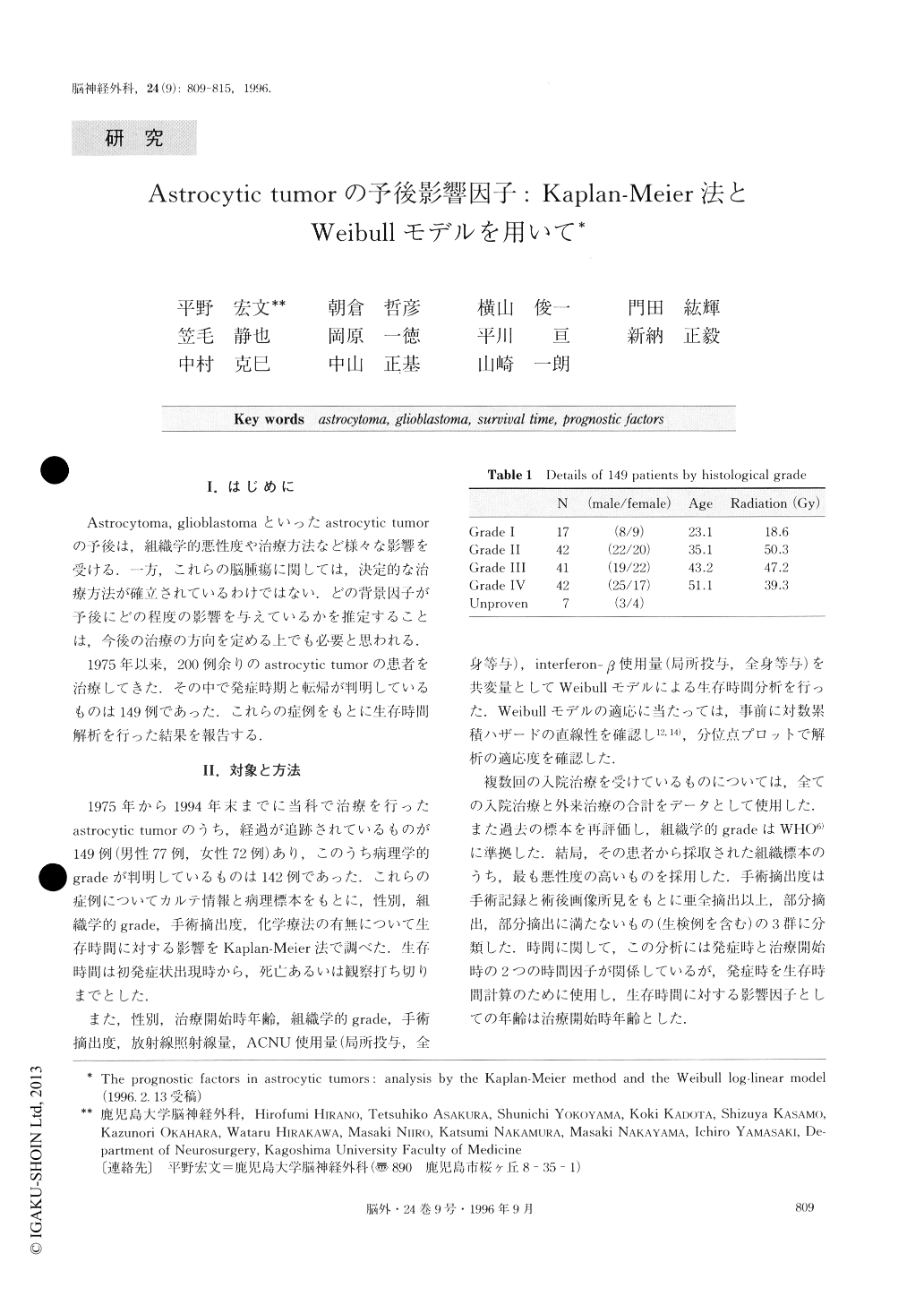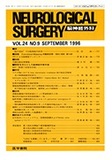Japanese
English
- 有料閲覧
- Abstract 文献概要
- 1ページ目 Look Inside
I.はじめに
Astrocytoma,glioblastomaといったastrocytic tumorの予後は,組織学的悪性度や治療方法など様々な影響を受ける.一方,これらの脳腫瘍に関しては,決定的な治療方法が確立されているわけではない.どの背景因子が予後にどの程度の影響を与えているかを推定することは,今後の治療の方向を定める上でも必要と思われる.
1975年以来,200例余りのastrocytic tumorの患者を治療してきた.その中で発症時期と転帰が判明しているものは149例であった.これらの症例をもとに生存時間解析を行った結果を報告する.
As the prognosis of astrocytic tumors depends on va-rious factors, identifying prognostic factors should be useful for developing strategies to cope with them. Be-tween 1975 and 1994, more than 200 patients with astrocytic tumors were treated in Kagoshima Universi-ty. Of these patients, 149 (grade Ⅰ: 17, grade Ⅱ: 42, grade Ⅲ: 41, grade Ⅳ: 42, unproven: 7) have been followed up. Records of these patients were retrospec-tively reviewed for age at the time of initial symptoms, gender, histological grade (WHO), extent of tumor re-section, radiation therapy, and administration of anti-cancer agents. We used the Kaplan-Meier method and the Weibull log-linear model to analyze the relation be-tween survival time and these prognostic factors. Sur-vival time was counted from onset of symptoms, and age of initial treatment was used as a covariant. The mean age of males at the initial diagnosis was 40.8 years (n=77), and that of females was 39 years (n =72). Using the Kaplan-Meier method, the mean sur-vival time of the 149 patients was 101 months (males; 72.7 months, females; 134.5 months). Mean survival time of grade Ⅱ was 144.3 months, that of grade Ⅲ was 95.2 months, and grade Ⅳ (glioblastoma) was 15.9 months. Histological grades and mean ages of the groups showed a positive correlation. Among grades Ⅱ, Ⅲ and Ⅳ, the Kaplan-Meier survival curves were sig-nificantly different (p<0.0001) according to the log-rank test. By the extent of surgical resection (subtotal or greater resection, partial resection, and less than par-tial resection), the mean survival time showed a signifi-cant difference (p<0.05) on the log-rank test. Howev-er, we could not detect a significant difference in sur-vival time between the group that received chemother-apy and the group which did not.
The Weibull log-linear analysis indicated that gender, age, histological grade (WHO), extent of surgery, and dose of radiation therapy were prognostic factors. Covariants of grades Ⅱ, Ⅲ, and Ⅳ made survival time 0.314, 0.179, and 0.069 times as long as that of grade Ⅰ. The survival time after “partial resection” became 1.415 times as long as survival time after “less than partial re-section”. The covariant of “greater than subtotal resec-tion” showed a prolonged survival time of 2.916 com-pared with that of “less than partial resection”. As for age at treatment, the older the patient was, the shorter the survival time. The rate was 0.986 for each year of age. Irradiation of one Gy increased survival time by 1.015 times. Chemoimmunotherapy (dose of ACNU and interferon β) could not be confirmed as an effec-tive covariant.

Copyright © 1996, Igaku-Shoin Ltd. All rights reserved.


